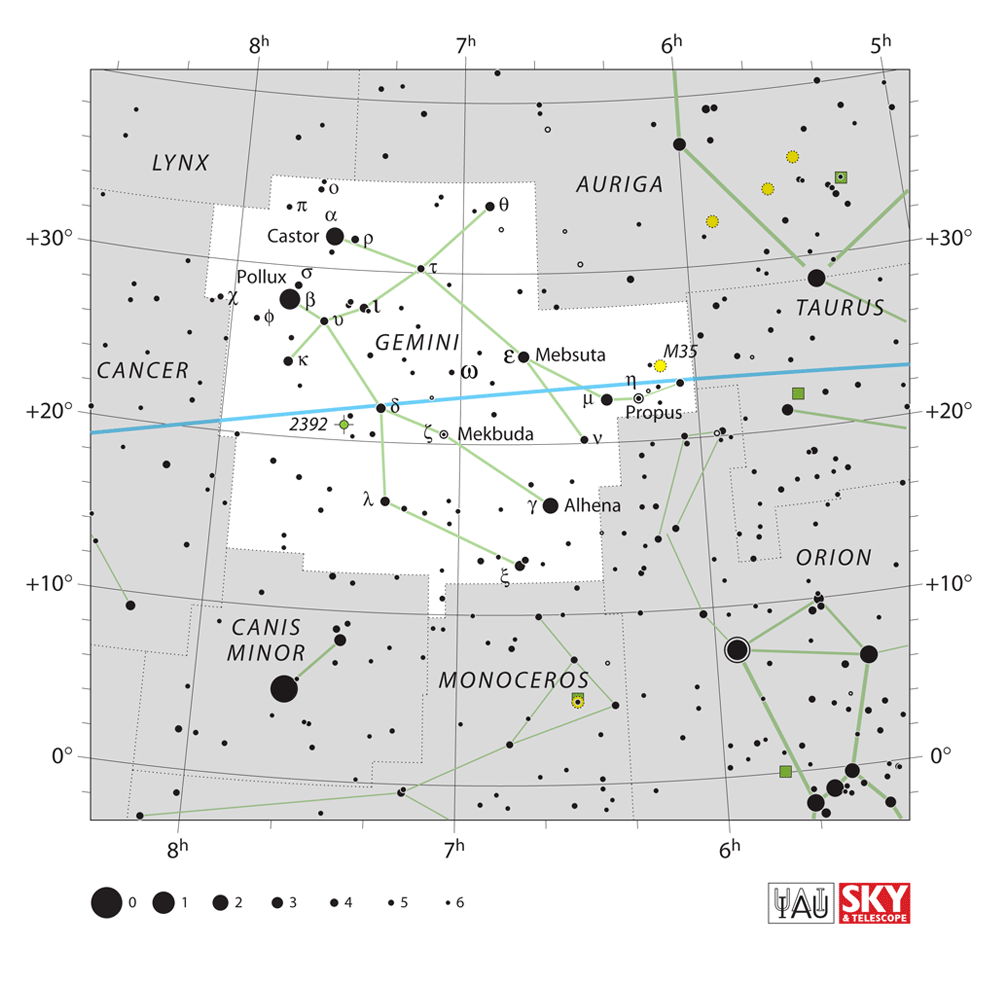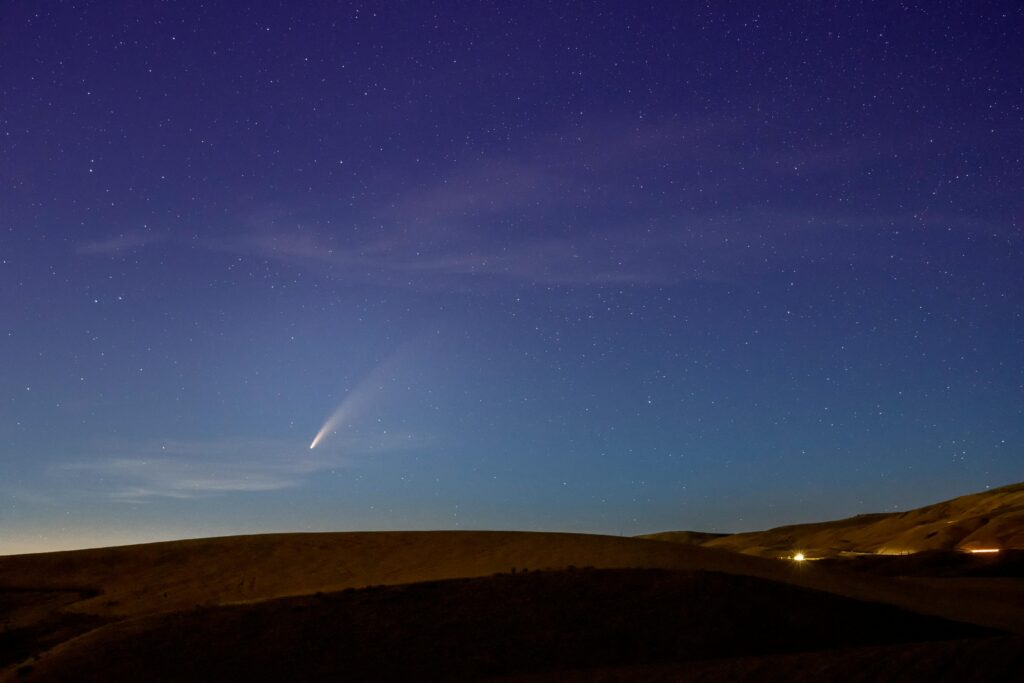Stargazing with Gemini
© freepik/tartila
The Gemini constellation, one among the 88 officially acknowledged in the night sky, is a mesmerizing expanse named after the Latin term for twins. First documented by the 2nd-century AD astronomer Ptolemy, it holds a distinguished status in ancient mythology, symbolizing the iconic twins Castor and Pollux from both Greek and Roman narratives.
Gemini lies between Taurus to the west and Cancer to the east, with Auriga and Lynx to the north, Monoceros and Canis Minor to the south, and Orion to the southwest. Positioned in the northern celestial hemisphere, Gemini is known for its distinctive shape, resembling two figures holding hands. This constellation is a treasure trove for stargazers, featuring a collection of fascinating stars, clusters, and nebulae.
In ancient times, Cancer marked the Sun‘s position during the northern solstice on June 21. However, due to axial precession, by the first century AD, this shifted into Gemini. In 1990, the Sun’s position during the northern solstice moved from Gemini to Taurus, where it will remain until the 27th century AD, before transitioning into Aries. The Sun will traverse through Gemini from June 21 to July 20, a pattern that will persist until 2062. When the Moon crosses through Gemini, its movement can be easily observed in a single night. Initially west of Castor and Pollux, it then aligns with them and ultimately appears to the east.
HISTORY OF GEMINI

The Gemini constellation has a storied history that spans back thousands of years. Its origins can be traced to ancient civilizations, where early astronomers observed patterns in the stars and incorporated them into their belief systems and cultural narratives.
In Greek mythology, the constellation is associated with the twins Castor and Pollux, the sons of Zeus and Leda. According to legend, the twins were born from separate eggs – Castor from Leda’s mortal husband Tyndareus, and Pollux from Zeus, making him immortal. The bond between Castor and Pollux was unbreakable, and when Castor was mortally wounded, Pollux begged Zeus to allow him to share his immortality with his twin. As a result, Zeus transformed them into the constellation Gemini, ensuring they would forever be together in the night sky.
The Gemini constellation also held significance in ancient Egyptian and Babylonian cultures. In Egyptian mythology, the twins were associated with the gods Horus and Set, while in Babylonian astronomy, they were linked to the myth of Gilgamesh and Enkidu. These diverse interpretations showcase the constellation’s enduring presence in various ancient belief systems.
The concept of Gemini as a zodiacal constellation, one of the twelve signs of the zodiac, originated in Babylonian astronomy. The zodiac served as a framework for tracking the movements of celestial objects and played a crucial role in ancient astrology and navigation.
ASTRONOMICAL FEATURES

The Gemini constellation is home to several noteworthy astronomical features, including stars, star clusters, and galaxies. Here are some of the key celestial objects within or near the Gemini constellation:
ALPHA GEMINORUM AND BETA GEMINORUM
Castor and Pollux are the twin stars that form the prominent heads of the Gemini constellation. They are two of the brightest stars in the night sky and hold a special place in ancient mythology. Despite their apparent proximity, Castor and Pollux are not physically connected; they are separate stars located at different distances from Earth. Castor, also known as Alpha Geminorum, is a complex system consisting of six individual stars. Pollux, or Beta Geminorum, is a bright orange giant, and it is one of the nearest giant stars to our solar system. These two celestial luminaries have captivated observers for centuries and continue to be a prominent feature in the night sky.
NGC 2168
M35, also known as NGC 2168, is a striking open star cluster located in the Gemini constellation. It is one of the finest examples of its kind and is visible to the naked eye under dark skies. M35 is relatively young, with an estimated age of about 100 million years, and it contains several hundred stars. These stars are loosely bound together by gravity, creating a stunning visual display when observed through binoculars or a telescope. M35 is a popular target for amateur astronomers, offering a captivating glimpse into the dynamic beauty of stellar clusters within our galaxy.
BEEHIVE CLUSTER
M44, commonly known as the Beehive Cluster or Praesepe, is a dazzling open star cluster situated in the constellation Cancer, although it is sometimes associated with the neighbouring Gemini constellation. Visible to the naked eye, M44 is one of the nearest open clusters to Earth, lying approximately 577 light-years away. It derives its name from its characteristic appearance, resembling a swarm of bees. This cluster harbours a diverse population of stars, making it an enthralling subject for both amateur and seasoned stargazers. M44 has fascinated astronomers and skywatchers for centuries and remains a prominent celestial attraction in the night sky.
JELLYFISH NEBULA
IC 443, also known as the Jellyfish Nebula, is a captivating supernova remnant located in the constellation Gemini. This celestial spectacle gets its name from its intricate, filamentary structure that resembles the tentacles of a jellyfish. IC 443 is the result of a massive star’s explosive demise, which occurred thousands of years ago. It now serves as a testament to the violent and transformative events that shape the cosmos. Located approximately 5,000 light-years away from Earth, the Jellyfish Nebula is a popular target for astrophotographers and astronomers seeking to capture the breathtaking remnants of a stellar explosion.
ESKIMO NEBULA
NGC 2392, famously known as the Eskimo Nebula, is a mesmerizing planetary nebula located in the Gemini constellation. Its name stems from its appearance, which resembles a face wrapped in a fur-lined hood, akin to an Eskimo. This captivating celestial object is the result of a dying star that has shed its outer layers, creating a luminous shell of ionized gas. The central star, which remains in the process of transitioning to its final stages, illuminates the nebula. Situated approximately 2,870 light-years away from Earth, the Eskimo Nebula enchants both amateur and professional astronomers, offering a splendid example of the beauty and complexity of the cosmos.
NGC 2158
NGC 2158 is a dense and visually striking open star cluster found in the Gemini constellation. Situated near the more famous cluster M35, NGC 2158 is significantly older and contains a higher concentration of stars. It presents a captivating sight through telescopes, with its numerous stars packed closely together, forming a radiant display against the cosmic backdrop. Although not as well-known as its celestial neighbour, NGC 2158 is a rewarding target for amateur astronomers seeking to explore the diverse array of star clusters in our Milky Way galaxy.
ZETA GEMINORUM
Mekbuda, designated as Zeta Geminorum, is a prominent variable star located in the Gemini constellation. It shines brightly as one of the key stars in this constellation. Mekbuda is a red giant star, meaning it is in the later stages of its stellar evolution. What makes Mekbuda particularly intriguing to astronomers is its variability in brightness. Over approximately 10 days, Mekbuda undergoes pulsations, causing it to fluctuate in luminosity. This characteristic makes it a notable star for researchers studying the behaviour of evolved stars. Situated roughly 1,100 light-years away from Earth, Mekbuda continues to be a subject of interest and observation within the realm of stellar astrophysics.
VISIBILITY AND SEASONALITY

The visibility and seasonality of the Gemini constellation offer a dynamic interplay between the night sky and Earth’s orbit. Depending on one’s location and the time of year, Gemini reveals itself with varying degrees of prominence. Understanding when and where to look for these celestial twins can enhance the stargazing experience, providing insights into the cyclical rhythms of the cosmos.
NORTHERN HEMISPHERE
- Winter: Gemini is most prominent during the winter months, starting in November. It rises in the east and is well-placed for observation in the evening sky.
- Spring: As spring progresses, Gemini moves towards the western horizon. By late spring, it becomes less visible and eventually sets in the west.
- Summer: Gemini is not typically visible in the summer months for Northern Hemisphere observers, as it is below the horizon during nighttime.
- Autumn: Gemini begins to rise in the east again, becoming more visible in the late evening. It continues to be well-placed for observation throughout the fall.
SOUTHERN HEMISPHERE
- Summer: Gemini is not visible during the summer months for Southern Hemisphere observers, as it is below the horizon during nighttime.
- Autumn: Gemini begins to rise in the east again, becoming more visible in the late evening. It continues to be well-placed for observation throughout the fall.
- Winter: Gemini is most prominent during the winter months, starting in November. It rises in the east and is well-placed for observation in the evening sky.
- Spring: As spring progresses, Gemini moves towards the western horizon. By late spring, it becomes less visible and eventually sets in the west.
METEOR SHOWER

The Geminids meteor shower is one of the most reliable and spectacular meteor showers of the year. It occurs annually in December, typically peaking around December 13th or 14th. What sets the Geminids apart from many other meteor showers is that they originate from an asteroid, rather than a comet.
The source of the Geminids is a near-Earth asteroid called 3200 Phaethon. As it travels through space, it sheds debris, creating a stream of particles. When Earth’s orbit intersects this debris stream, the particles enter our atmosphere and burn up, creating the streaks of light we observe as meteors.
The Geminids are known for producing a high rate of meteors, sometimes reaching up to 120 meteors per hour during its peak. They are also known for their relatively slow-moving meteors, which can be long-lasting and vibrant, making them a favourite among meteor enthusiasts and stargazers.
To observe the Geminids, it’s best to find a location away from city lights with a clear view of the night sky. The best time to watch is typically after midnight when the Gemini constellation (the radiant point of the meteor shower) is higher in the sky. However, Geminid meteors can be visible in all parts of the sky, so it’s not necessary to focus solely on Gemini.
The Geminids meteor shower is a celestial spectacle that continues to captivate and inspire observers worldwide, making it a highly anticipated event in the astronomical calendar.
